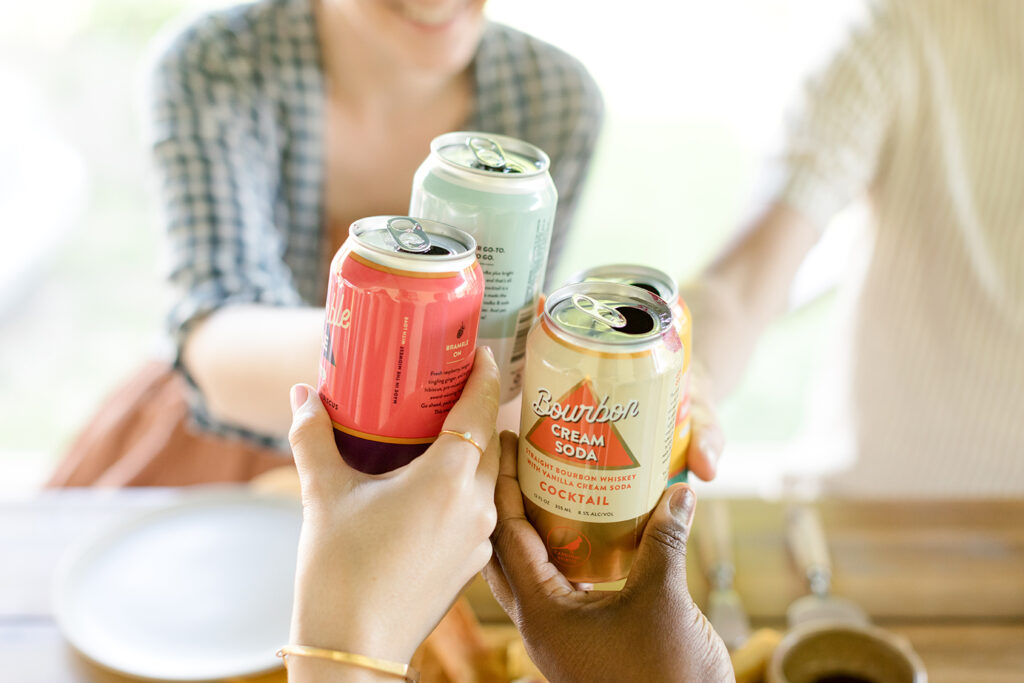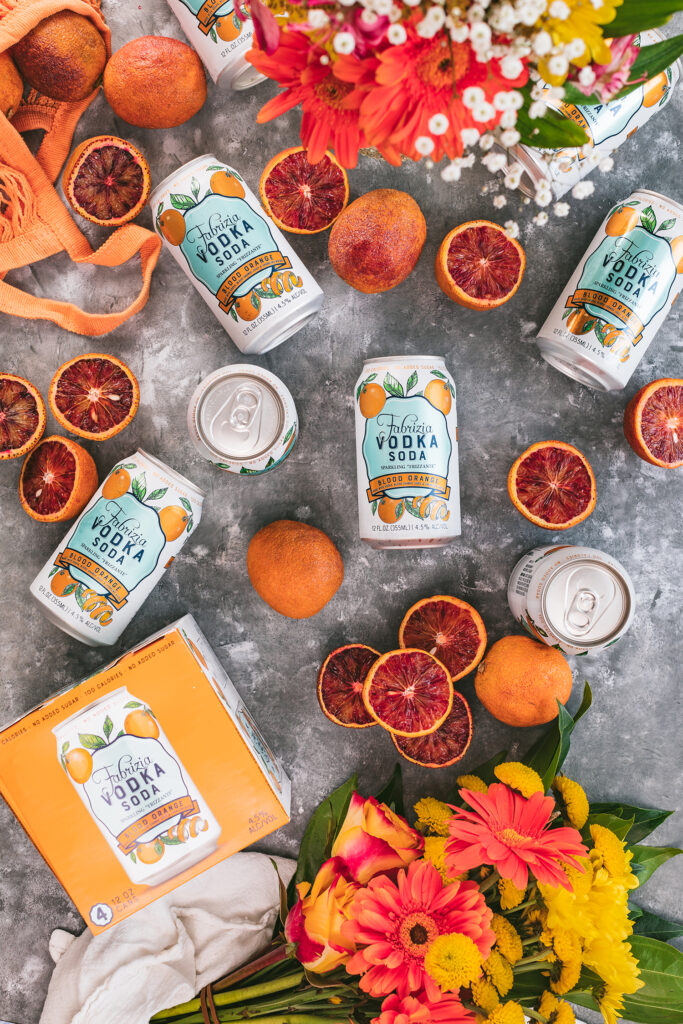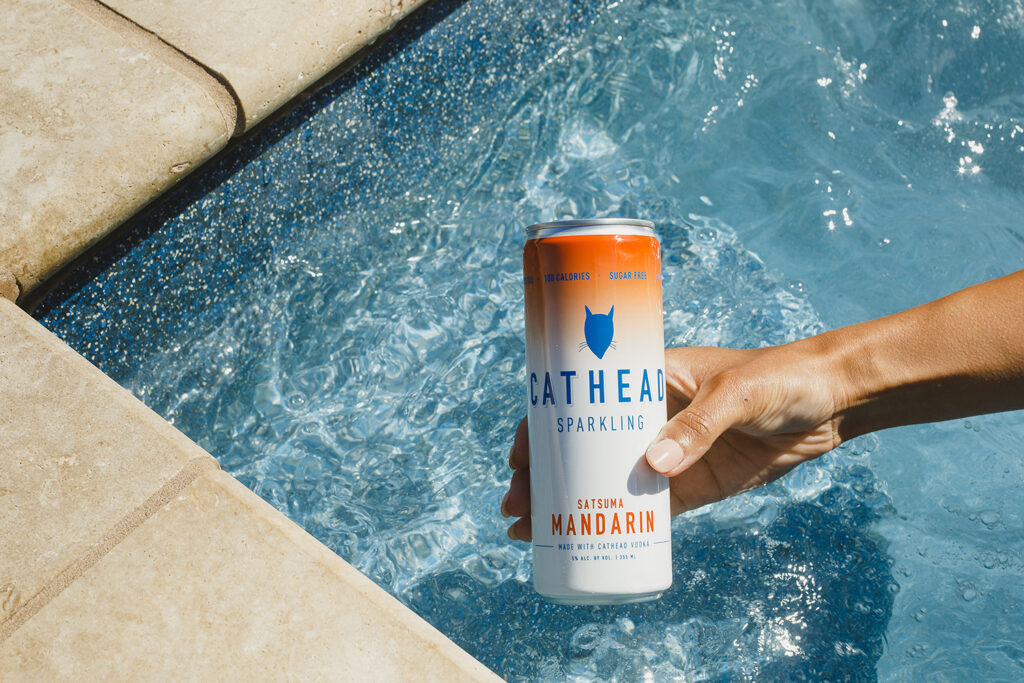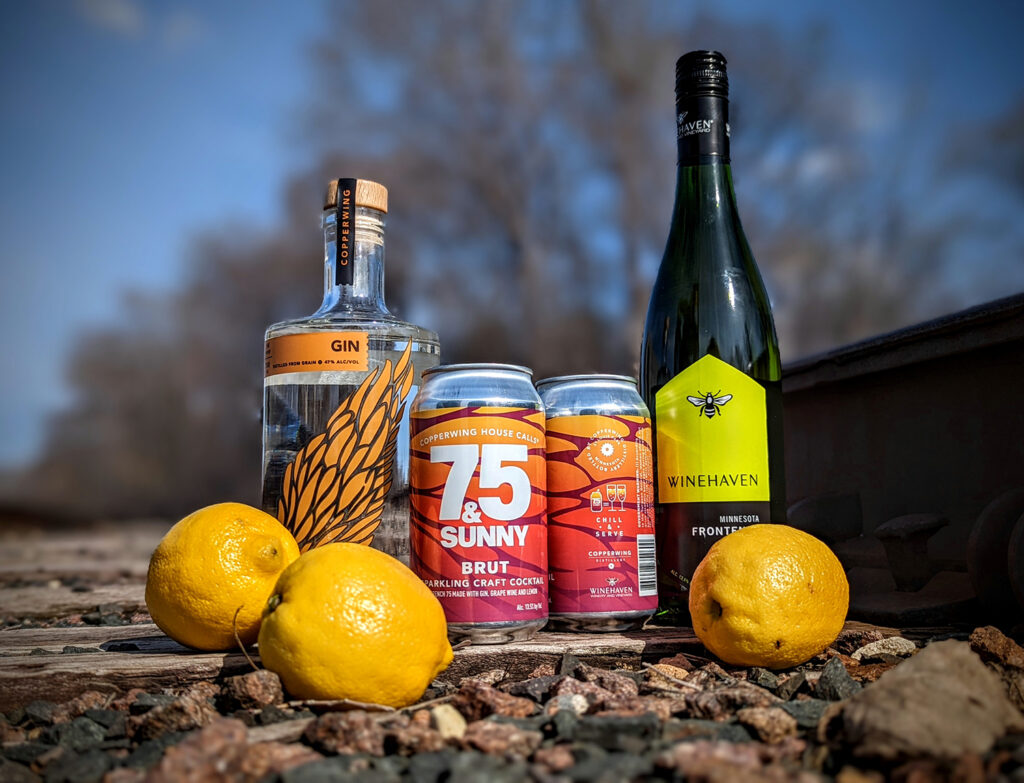
The commercial begins with black and white footage of average looking adults gazing into the camera. “Here’s to the lazy ones,” says the narrator, in a nod to an iconic Apple ad. “The renegades. The outliers. The unsung geniuses. The ones who live life differently—working smarter, not harder.” A woman tenderizes meat with a massage gun. A man uses a blowtorch to melt the snow in his driveway. Another man relaxes in a chair, holding a leash while his dog runs on a treadmill.
In each scene, only one item appears in color—canned cocktails.
“And while some may see them as the lazy ones, we see pioneers,” the narrator concludes. “Because the ones who make the most of their time are the ones who are ahead of it. Cutwater: bar-quality cocktails in a can.”
The ad for AB InBev-owned Cutwater Spirits aired during this year’s Super Bowl, and it was yet another reminder that the spirits-based ready-to-drink (RTD) cocktail category—which includes products in cans, bottles and even pouches—is exploding. John Cena, Sarah Jessica Parker, Rosario Dawson and Vanessa Hudgens are among a group of celebrities promoting a new brand of RTDs. Hard Rock is launching a line. Diageo recently opened a $110 million manufacturing site devoted to RTDs. There’s a bar in London that serves only cans, including RTDs. And Sam Calagione of Dogfish Head Craft Distillery and Dogfish Head Distilling Co. says the “summer of ‘22 is going to be the summer of the spirits-based RTD—just the way that a couple of summers ago it was the summer of the seltzer.”

He may be right. Although some industry reports—and consumers—lump spirits-based RTDs into the same category as malt-based hard seltzer, analysts who make a distinction between the products see spirits-based RTDs skyrocketing. “Growth wise, spirit RTD cocktails are just off the charts right now,” says Danny Brager, a beverage alcohol industry consultant and the former leader of the Nielsen Company Beverage Alcohol Practice. Spirit-based RTDs, however, have a long way to go to catch up with seltzer sales. According to Data from NielsenIQ, off-premise sales of hard seltzer in 2021 were $4.6 billion, compared with nearly $800 million for spirits-based RTDs. However, when looking at dollar percent changes for the past 52 weeks through Feb. 26, spirit-based RTDs were up 106.2% compared to hard seltzer, which increased by 5.3%.
Additionally, IWSR has forecasted that spirits-based RTD volume in the U.S. grew by 53% last year, and is projected to grow by 29% compound annual growth rate (CAGR) 2021-2025.
While craft distillers face numerous barriers to entry, distribution challenges and markets that lack tax parity for spirits-based RTDs, many independent producers are joining in on this rapid growth and finding success. At Astoria, Oregon-based Pilot House Distilling, co-founder Larry Cary says the RTD side of the distillery’s business comprised about 10% of his time two years ago. Now, production of the distillery’s Astoria Mary, Astoria Mule, Gin & Tonic and Vodka Soda accounts for half of Cary’s time. “Watch out what you get into,” he says. “These things move. A lot of my time is now spent just planning cans.”
So what’s driving the boom? A global pandemic that forced consumers out of bars and into their homes, for one, but there’s also the overall convenience angle and the fact that RTDs can demystify spirits for some consumers.

“Spirits are great and I love them, but getting together socially with spirits is a challenge at times,” says Jeff Wuslich of Bloomington, Indiana-based Cardinal Spirits. “You show up at a party with a bottle of wine and a six pack, everybody knows what to do. You show up at the party with a bottle of gin and they’re like, ‘Whoa, Jeff! What are you doing?’ And you’re like, ‘No, I just need some simple syrup. Do you have any citrus? Ok, great.’
“And then you’re stuck in the corner all night making cocktails. Having everything in a can is amazing.”
Cary has a similar opinion.
“I don’t see our bottle sales going away, but if I’m going to a tailgate or a party, or if I’m going camping, I’ll bring a four pack [of RTDs],” he says. “It’s real easy. I don’t have to bring glass with me. I don’t have to mix cocktails. I don’t see it ever going away and I’m surprised it’s taken this long to catch on in the U.S.”
And it’s all the better to help promote your bottled spirits, according to Richard Patrick of Jackson, Mississippi-based Cathead Distillery, which launched its RTD lineup in 2021. “We have a walking billboard that people drink out of now,” he says.
Monica Pearce of Tenth Ward Distilling Co. in Frederick, Maryland, can relate. “We’re hitting a whole different target [audience that] we hadn’t hit before,” she says. “It hasn’t affected our spirits sales at all. It probably has brought more awareness to us because there are some stores that carry our cans now that never carried our spirits.”
Hurdles for Craft Distillers
While analysts and distillers see a bright future for RTDs, existing and would-be producers of craft spirits-based RTDs face numerous challenges in the category. According to conversations with more than a dozen distillers across the U.S. and a recent survey by the American Craft Spirits Association, some of the biggest hurdles include tax parity, fair distribution, supply chain woes and finding shelf space, along with the cost and challenges inherent in developing a high-quality, shelf-stable RTD in the first place.
When first contacted about this story, Melissa Katrincic of Durham Distillery—an early producer and champion of RTDs—implied that the category is so rife with headaches that it may not be worth it for craft distillers. “Unless a distillery is planning to have RTDs as their priority SKUs with significant marketing dollars to support their traction and growth, I do not recommend this category,” she wrote. “It pains me to say that as we were one of the first to market with them, but yeah, it’s not a good scene.”
Katrincic and her husband, Lee, founded the distillery in 2013 and launched their gin in 2015. In 2018, they released their canned gin and tonic and a vodka soda, both at 8% ABV. A 2020 presentation by Lee on RTD production mentioned that the distillery had “no issues with RTDs since we launched.” But competition crept in from RTDs with half the ABV for the same price. There were also supply chain issues with aluminum, struggles to secure prime store displays and other concerns. Melissa says that by the summer of 2021, sales were declining and the margins were too thin. Now, the distillery is only distributing its RTDs in North Carolina, a control state that does not allow sales of spirits-based RTDs in grocery or convenience stores.
Katrincic says she wants aspiring craft spirits-based RTD producers to enter the space with eyes wide open. “I want everyone to understand the hurdles in front of them,” she says. “If it’s a passion that they have and they think they have something that’s going to set the world on fire, go for it. But if they think it’s a way to gain more revenue for their home distillery, I highly caution against it. And I didn’t even get into all the tax implications.”
Katrincic says that the North Carolina Alcoholic Beverage Control Commission is making more margin off of RTDs than anything else in its portfolio because spirits-based RTDs are taxed at the same rate as an 80-proof spirit. The same is true in many other states. Meanwhile, malt-based hard seltzers that have similar ABVs are taxed at the same rate as beer. Some of those even advertise spirits-like flavors on their cans.

“There’s all these brands that are meant to look like they have spirits in them, but they really have flavored malt beverage,” says Phil Mastroianni of New Hampshire-based Fabrizia Spirits, a rectifier that produces several RTDs and limoncello. “That is a real challenge for producers of [spirits-based] cocktails. … If the flavored malt beverage brands are gonna be able to sort of blur the lines of what their alcohol is, at least tax [us all] the same, at this low proof.”
Despite pushback from a few beer trade associations, some states are evening the playing field for spirits-based RTD producers. In 2021, Michigan and Nebraska reduced excise taxes on low-alcohol RTDs. And in some control states like Idaho, Mississippi and Virginia, low-alcohol RTDs are now sold at grocery stores. “What that enabled us to do [in Mississippi] was go from about 300 points of retail distribution to about 7,000 overnight,” said Patrick of Cathead.

The RTD-friendly legislation signed last year by Michigan Gov. Gretchen Whitmer raised the ABV ceiling from 10% to 13.5% and reduced the tax on mixed spirits from 48 cents to 30 cents per liter. It also paved the way for self distribution of canned cocktails.
According to Jon O’Connor, who is the co-owner of Long Road Distillers in Grand Rapids and the president of the Michigan Craft Distillers Association, the advocacy strategy for the legislation was all about parity. “We don’t want to be treated special,” he says. “We just want to be treated fairly and have parity with our other brothers and sisters in the craft beverage industry that are around us.”
The new law is already making a big impact for Long Road. In March O’Connor said Long Road was already approaching what it produced in all of 2021, and the distillery has hired a full-time sales person to meet the strong demand from retailers across the state. “Now that we have the resources to do it,” says O’Connor, “they’re chomping at the bit to get these and be a leader, because they see the data that supports the consumer demand [for RTDs].”

Production and Packaging Considerations
Assuming a distillery has accounted for all the regulatory hurdles and has a strategic marketing plan, there’s still the reality of production, which is neither easy nor cheap. Installing a canning line could be less than $100,000, but depending on needs, the price could triple or quadruple. For that reason, a lot of distillers start out working with mobile canners like Iron Heart Mobile Canning.
Brothers Nick and Phil Mastroianni co-founded Fabrizia Spirits with an initial focus on limoncello made from Sicillian lemons. They started bottling RTDs in 2015, and added canned offerings in 2017. It started with a mobile canner, but Phil says it eventually made more sense to invest in a canning line. “Once you see the certainty and get the right size canning line for your operation,” he says, “you’ll make more money and you’ll open yourself up to co-packing opportunities for other craft distillers or brands.”
The co-packing route has been effective for Hollywood, Florida-based Ziami Distillery. Founder Victor Olshansky says RTD production now accounts for 70% of the distillery’s volume and 50% of its revenue. “We ended 2020 coming off of hand sanitizer, still having our own rum brand and having one or two co-packing clients in tow with bottles,” he says. “But then in 2021, once we added the canning capability, we very quickly started adding a lot more canning clients to the list.”

For some distillers, it makes sense to work with a brewer that has mobile canning equipment. Or in the case of Copperwing Distillery in St. Louis Park, Minnesota, a kombucha maker. The distillery has a line of bottled RTDs and won a silver medal and two bronze medals in ACSA’s 2021 Judging of Craft Spirits in the ready-to-drink category. But for a new release of canned cocktails, owner Kyle Kettering struck a deal with the neighboring company. “It’s a good fit,” he says. “The utilization of all of the equipment isn’t even near 50%, so there’s a lot of available time. You just strike a deal with them to share each other’s time and equipment and you can make things happen for a lot cheaper than someone you don’t know.”
When it comes to recipe formulation, Kris Bohm, the owner of Distillery Now Consulting, recommends starting with ingredients that are known to be shelf stable. Bohm has been intimately involved in the launch of RTD programs for four distilleries, and he says fresh lime juice is troublesome, unless you plan to pasteurize. “Most of the successful RTD cocktails that I’ve seen developed, or have been a part of developing, have been developed very much in a lab setting,” says Bohm. “Trying to take the cocktail out of the bar and put it in a can doesn’t work for most people. For a lot of folks, they develop it using shelf-stable extract flavors, sweeteners and acids and often will produce something that tastes just as good as a cocktail in a bar without a lot of the big issues that come up with using fresh ingredients.”
Those big issues could lead to product recalls. That’s why he’s also a proponent of rigorous quality assurance and shelf life stability testing. “Testing all of those things before you actually take the product to market is essential to the success of a ready-to-drink cocktail,” he says. “You don’t want to go and can something that’s not shelf stable and have it ferment in the can and explode on the shelf.”
Lee Egbert of Minnetonka, Minnesota-based Dashfire (makers of premium bitters, RTDs and liqueurs) agrees that quality assurance should be top of mind for all producers. “That’s what everybody who does these long-term RTDs should be losing sleep over—if they don’t already—is shelf stability and creating a crummy reputation,” he says.
Cary advises producers to constantly monitor seams. “Through the production line as we’re canning, I’m constantly bringing them out, checking my seams,” he says. “I have experienced poor seaming and lost full pallets in the warehouse, that is truly a horror story.”
Wuslich of Cardinal Spirits also suggests that distillers making carbonated RTDs should consider carbonation as an extra ingredient. “If you taste a Coke, it almost burns your tongue,” he says. “You get that aggressive carbonation. Some of ours, we want that. Some of them we want to be a little more mellow. Trying to nail that carbonation level is key.”
And before scaling to a large run, Elliot Macaluso of Ziami recommends experimentation on a small scale. For him, that started in his office with a lab still, a single canning system and a SodaStream. “Before we even canned our first product with a canning line,” he says, “I think I must have canned 50 to 75 single cans myself, making sure that I knew every which way that the operation worked before we actually went into canning in bulk.”
Of course, RTDs are not limited to cans, and some distillers offer a mix of canned and bottled RTDs ranging from low to high proof. Savage & Cooke of Vallejo, California, opted for 200-mL glass bottles for its Home School products, which it markets as bottled craft cocktails rather than RTDs. Home School includes a 50-proof Negroni and a 70-proof Blood Orange Manhattan, which earned a silver medal in ACSA’s 2021 Judging of Craft Spirits.
“These are real cocktails and they’re meant to be served over ice and garnished,” says general manager Lauren Blanchard. “They really mimic the experience that you would get when you’re in your favorite on-premise restaurant [or] bar. … We never say that we’re in the RTD category because we don’t really feel like we are in a lot of ways. How do you compare yourself to Cutwater and High Noon? It’s such a different category than what we are.”
There’s a similar ethos at Hudson Valley Distillers in Clermont, New York, which launched its Hudson Cocktail Co. line of bottled cocktails in 2021. The cocktails are 21% ABV and higher and are marketed as ready to pour rather than ready to drink. Co-owner and marketing director Stephen Theiss says the distillery made an intentional decision to steer clear of low-ABV canned offerings. “It was like the whole herd was running in that direction, and that’s just not what we’re about,” says Theiss. “We want them to be in a bottle and a little bit more [of an] elevated experience. I want people to feel like they’re drinking a bartender-quality cocktail at home … not a half-hearted Cosmo.”

Dashfire makes high-proof RTDs in bottles and cans, but its cans are not aluminum. A lineup that includes multiple Old Fashioneds, a Martini and more are packaged in 100-mL cans made of tin.
“Aluminum cans can’t hold the high-proof alcohol cocktails,” says Egbert. “The liner on the inside of an aluminum can isn’t as strong as the liner on a tin can.”
Dashfire believes strongly enough in the tin can manufacturing and RTD business that it will be announcing a major investment to produce up to 20 million cans per year for their products as well as others. Egbert says they plan to make the cans (in 100-mL, 200-mL and 250-mL sizes) available to new customers sometime in 2023.
“Currently, all suppliers of these small tin cans are only in China, and we all know what that means both in terms of freight and the cost to the environment,” says Egbert. “We’re excited to bring that production to the U.S. Having low minimums of printed cans will really help craft producers and is far more environmentally conscious than label-over or shrink sleeves, which are not as easily recycled.”
Marketing and Differentiation
Bohm likes to remind RTD upstarts that sales and marketing go hand in hand with production. “Successful sales of alcohol only happen with businesses that equally invest in production, sales and marketing,” he says. “If that investment isn’t made to all three of them, more than likely you won’t succeed.”
Echoing Bohm is Kelly Gasink, the co-founder of Austin Cocktails, which was recently acquired in full by Constellation Brands. “You really can’t go to market casually with a canned offering,” says Gasink. “If you’re gonna get buyers to carry it outside of your distillery, you need to show up with marketing support and a strategy. Because now, for a category that had about three players in it originally, it’s absolutely inundated and buyers are having a really hard time making distinctions among products.”

That’s why many distillers interviewed for this story recommend cornering your home market.
“My recommendation is to stay hyper local,” says Dogfish Head’s Calagione. “Can and sell it direct, or maybe with one distributor in your home state. But to go into a 5-, 10-, 15-state footprint as a non-national brand with spirits-based cocktails is going to be challenging. I think you have to go for it and be national or stay local with your offerings.”
Katrincic urges RTD producers to be disruptive, and Brager says they should strive to bring something unique to the market.
“If you do get into it,” he says, “it feels like you have to have something that’s different than all the other ones that are out there, or some background story that will cause a consumer to choose you rather than the other 273 brands that are out there.”
So is it worth it for a craft distillery to enter the category? Blanchard of Savage & Cooke suggests starting the conversation with a distillery’s key supporters.
“Talk to your consumers,” she says. “Talk to your fans. Talk to your friends and family that support the brand and find out if [this is] truly something that your distillery could be successful in. If you’re just wanting to because it’s a big category, it’s not really the right reason.”
In other words, don’t be lazy about it.
Editor’s Note: This story first appeared in the May/June 2022 issue of CRAFT SPIRITS magazine.

